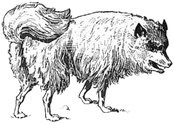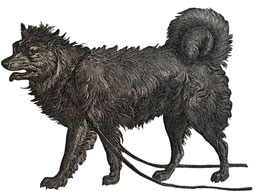The Giant Spitz
A breed portrait
Preface
What Spitz-character is cannot be missed by anyone who owns eyes and ears! And the name also fits perfectly - so German word "Spitz" means "peak", "sharp" or "pointed". Whether you take his appearance or his nature, everything is tailored to "Spitz" and "Spitz" (peak and sharp): from the pointed foxy Spitz face, to the pointed ears, to the quick attention that characterizes every proper Spitz. He is full of temperament, the sanguine among dogs, with all the good and problematic qualities of his disposition. He just always has something to do. Toujours en vedette. You can't blame him for often being suspicious, because that's just how it is with a dog as alert as our German Spitz. His territorial sense is enormous and the craftsmen of yesteryear could sing a song about it, as they liked to give the farmhouse a wide berth, in whose door stood a large Spitz. And there was often one there. But if they tried their luck, because the farmer's wife seemed quite friendly, the Spitz would stand next to it growling and not move from the spot until the strangers had left again. He would often growl after them until they reached the road (For the Spitz, every visit is actually suspicious, no matter how warmly he is greeted by his master or mistress. Spitz may think that his master could be wrong and that he therefore has to be ready in case of an emergency).
Historical
Because in the past - when our Spitz was still a working dog - there were only two size categories "large" and "small" for him (the varieties "Mittel Spitz" and "Miniature Spitz" were not yet known back then), whenever I speak about the Spitz I mean the large or Giant Spitz.
The country of origin is Germany and as such is internationally recognized by the FCI as keeping the studbook for the breed. In addition to the name "Spitz", our dog breed was also previously called "Pomeranian" (coming from the former Eastern German Region "Pomerania"); In England, France and Sweden they are still called this today:
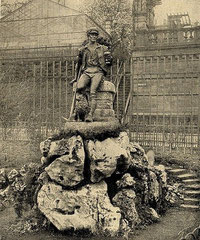
English: "Pomeranian"
French: "Lou-Lou de Poméranie" and "Chien de Poméranie"
Swedish: "Pomerska Spetsen"
In any case, there must be something to it: whether the Spitz was particularly often seen on wagons from Pomerania - as the Pomeranian national dog, so to speak - or whether the Pomeranian Spitz breed was simply very famous, which was primarily dedicated to the white Spitz.*
The traditional homeland of the black Spitz, however, was in Southern Germany, in Württemberg. The black Giant Spitz, which was also called "Weinbergspitz" ("Vineyard Spitz"), was kept by Swabian winegrowers to guard the vine plants. The "Urban Monument" in Stuttgart, which showed a young winemaker with his "Weinbergspitz", is a reminder of this important service of the Giant Spitz. Unfortunately, the urban monument was melted down after WW2.

Our large Spitz was also found until the middle of the last century (until the building was demolished) in a relief above the entrance door in the portal of the house of the "Rheinische Landesgenossenschaftskasse" (kind of bank) in Cologne, which showed the large Spitz as guardian of house and farm in agriculture. Cologne was once the center of the agricultural cooperative system and counted over 200,000 farmers, craftsmen and traders among its association members. The fact was and is that the German Spitz belongs to a German farming family - as the relief in the picture shows.
The medieval, so-called "Mistbeller", was a medium-sized, yapping guard dog - certainly a large Spitz - but one step lower in reputation than the serious Hovawart. “Spitzhundt” was a swear word back then, and there has been no shortage of attempts throughout history to make the Spitz bad. Every virtue has its downside and the temperament of the Spitz may tempt one to call the suspicious guardian grumpy, quarrelsome and sneaky. But who hasn't been slandered because of their virtues! 😉
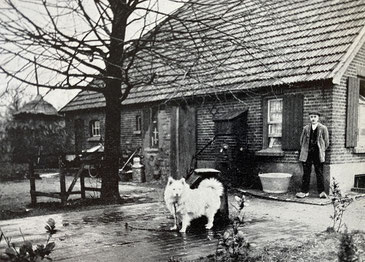
In some places where the German Spitz was found, it was also called “Fuhrmannsspitz” ("carter's Spitz"). Somebody drove potatoes to the market - a Spitz sat on top. The rag dealer came driving along - the Spitz was sitting next to him. When the vegetable farmer's cart rolled through the village, there was a Spitz running behind it. But whatever the driver had loaded, he could safely leave his car and go for a drink at the inn. If one of them got too close to Spitze's property, he would run around it, yapping loudly. As Fuhrmannspitz, the breed also traveled a lot around the world and ensured its spread and appreciation. Beckmann already described their good qualities:
"The Spitz surpasses all other domestic dogs in vigilance. Constant, suspicious and observing all events in his environment, the slightest suspicion immediately alarms him. The concern for the property entrusted to his care usually drives him to the extreme, and thus shows a devotion that is often downright touching. "
Personality and nature
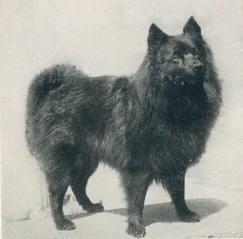
While the small Spitz variants were mostly kept as toy and companion dogs, the Large Spitz was primarily a working dog until the middle of the last century. This has remained the same in its nature, which is why the proper Giant Spitz is still far primitive and far more dutiful than its smaller relatives and is not so easily impressed by everyone. Its good qualities have largely been preserved so far, but have recently been eroded by bad breeding, which is evident from the fact that there are now quite a few Giant Spitzes that are not averse to hunting, for example, or allowing themselves to be petted by complete strangers. Sassenberg - a former chairman of the German Spitz Club - wrote in 1951:
"Our Spitz must never become a trendy breed when it comes to breeding goals, because this usually causes the original character to be lost over time."**
It would be better to continue breeding the Spitz for its intended purpose and the breed standard: as a guard dog that will not leave the property entrusted to it under any circumstances because it is loyal to the farm and has no interest in hunting or straying. For this reason, the Spitz must not be capable of any endurance performance in order not to be able to rush the deer. The standard also expressly emphasizes the short, stocky figure, with the back as short as possible. If a German Spitz is built like that - i.e. short and stocky - then he can't be a hunter! And if he does chase a rabbit or a deer, after a short sprint he realizes that his efforts are in vain. But if the Giant Spitzes are bred too much for height and at the same time their backs are too long, then the breeding direction is too much towards endurance runners. Nowadays, one would call it "Form follows function ". A reliable, loyal guard dog also needs the specific body of a guard dog.
Excerpt from FCI Standard No. 97/12.11.2019/D - German Spitz:
"The German Spitz is always attentive, lively and extraordinarily attached to its owner. It is very teachable and easy to train. Its natural distrust of strangers and lack of hunting instinct make it the ideal companion and family dog and watch dog for home and farm. It is neither timid nor aggressive. Indifference to weather, robustness and longevity are its most outstanding attributes."
For many centuries, the large Spitz - alongside the Wolfsspitz - was the watchdog par excellence and was definitely feared by strangers, because an attacking Spitz fights cunningly and unpredictably. But no matter how Giant Spitze's courage and bravado may be towards strangers, he melts away in the presence of his master and his family and maintains his absolute harmlessness towards children, family members and smaller animals throughout his life. The Spitz is also endlessly enthusiastic and likes to learn little tricks or any other nonsense - the main thing is that he is there. However, he doesn't take orders from strangers. Logical: A guard dog that follows the commands of strangers (including those of the burglar) is quickly unemployed, because he is a poor guard dog.
On the contrary: Like all Spitzes, the Giant Spitz is always at least neutral to highly suspicious of strangers. This mistrust tends to range from gentlemanly reserve to a clear warning if, in Spitze's eyes, the stranger is a little too interested in the master-dog-team or behaves conspicuously.
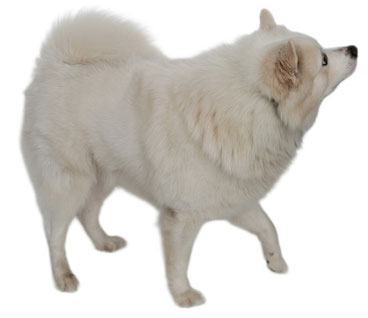
And yes: the Spitz barks! He's not as quite as much barking as his smaller cousins, but you can't turn him off completely. If there is no appropriate training, the large Spitz will do exactly what it has been bred to do for centuries: report everything suspicious, really everything! With consistency and patience, you can get the barking under control very well. I speak from my own experience, as I live with two large Spitzes in an apartment building on the first floor in Berlin.
You can certainly influence both the way of reacting on strangers and the alertness through training - but you shouldn't completely discourage it, as these character traits are part of the German Spitz's very own nature.
The Spitz character also includes a great sense of independence and freedom. Like all of its cousins, the Spitz always reacts to coercion and tyranny with rebelliousness, so you should avoid too harsh training. A Spitz is only a real Spitz when kept in freedom. Then he is curious, loyal and self-confident, but extremely undemanding and inexpensive to maintain. Owners should respect this penchant for freedom even today and, for example, let their Spitz run free as much as possible. Or to quote Eyke Schmidt-Rohde (author of the book "Der Spitz" and breeder of kennel "vom Seerosenweiher"):
"Many dog owners don't know that for every dog, except small breeds, the normal human walking pace is painfully slow. Our four-legged friends' natural gait is a brisk trot. That's why dogs, out of consideration for road traffic, are always on a leash to be deplorable pitiful creatures."
German Spitzes are incredibly intelligent, you can read that in every description of the breed. But be careful! This coin has two sides, because he likes to use his intellect to cleverly and charmingly circumvent regulations or to brilliantly outsmart his master. The stubbornness that the Spitz is said to be usually results from misunderstanding or unclear status. He needs really consistent training, without which he will sooner or later do whatever he wants. His alleged ease of handling and his suitability as a beginner's dog should be treated with caution. A beginner who knows exactly what he wants and gets it done will certainly get along very well with a Spitz, but it all depends on the person and their personality. The Giant Spitz is one thing definitely not: a breed for everybody. He needs a human with character.
Breed standard

The large Spitzes impress not only with their unique character, but also with their beautiful appearance: from their smooth face with thick lion's mane like ruff, the clever, slightly slanted almond eyes look curiously back at you; triangular, pointed ears register every sound. The Giant Spitz comes on small cat's paws and has a thick coat of hair that protects its short, tight body from sun, wind, rain and even snow.
According to the current standard, the size of the German Giant Spitz is 45 +/-5 cm, which means it is not that much smaller than the Wolfsspitz (especially not since the Keeshonds have been integrated into the Wolfspitz standard, but that is a different topic). With a weight of around 15-20 kg, the Spitz is a dog that should be taken seriously. Until the beginning of the 20th century, however, it was significantly smaller than today and in terms of size was more similar to today's Mittel Spitz, which at that time was not yet an officially recognized variety of the breed.
Giant Spitzes are available in the coat colors white, black, brown and "other colors", which include colors such as orange, blue, wild colors, gray and piebald. Currently, all different colors, the so-called “colorful” large Spitzes, are not permitted in the German Spitz Club (FCI).
The double coat itself - like the whole Spitz - is very easy to care for and undemanding, and since it is coated with Teflon, you don't need to bathe the Spitz: the dirt dries and then falls off on its own. The fur protects against cold, heat and injuries. There is NEVER shearing! Often the hair does not grow back normally afterward, and the Spitz looks crabby for the rest of its life. Even if Spitzes are neutered, the fur often degenerates into a misshapen pile of plush that is really difficult to care for. Therefore, shearing and castration of Spitzes should only be carried out for reasons of illness.
Black Giant Spitz

In the southern German wine-growing regions, the black Giant Spitzes were particularly widespread, guarding the farm during the day and keeping watch in the vineyards at night (which is why they used to be called "Weinbergspitz"). The black Giant Spitz - a medium-sized dog that was invisible at night due to its color and who is very, very agile - was predestined to keep both human and animal thieves away from the grapes. In addition to birds, he also drove away foxes and martens. Since martens in particular are very defensive animals that can also be dangerous to dogs, so the black large Spitz always had to be a little sharper than the other large Spitzes.
For a long time, the black coat color was the preferred color for the Giant Spitzes, but it was only in the 1990s that the tide turned, and the blacks were overtaken by the white Giant Spitzes.

An even sharper version of the black Spitz is the blue Spitz. Sometimes the fur color of the Giant Spitz is also referred to as “grey” instead of the color “blue”. However, I don't know how and why. It is important at this point that the gray Spitz should not be confused with the Wolfspitz. In contrast to the Wolfspitz, the gray Giant Spitz not only does not have a mask, but differs from it in both the structure of its fur and its body structure.
Due to concerns about animals that could be prone to diseases such as alopecia due to their blue coat color, breeding with these animals has now been severely restricted in Germany. However, in view of the many blue Spitzes that have appeared in the stud books in the past, I also think it is more likely that the German Spitz is one of the dog breeds whose blue coat color is not linked to the defective gene that causes the diseases.
White Giant Spitz

The large, white Spitz was actually always the typical guard of the farm and was also used to herd the sheep. The white coat color is of great importance for a herding dog because it allows you to distinguish it from a wolf from a distance and at night.
At the beginning of the 20th century, many were exported to France, where they were unfortunately crossed with Samoyed. For example, the French champion “Prince LuLu” came from this outcross. Mrs. Alice Gatacre used to call the French version of the German Spitz not as "Lou-lous de Poméranie" (official name), rather as "Chien Nordiques" (Nordic dogs) because of the many crosses of other breeds.
Before WW2, there were still a lot of white Spitzes in Germanic region (Swiss, Austria and Germany). At the World Dog Show in Frankfurt in 1935, a white male Giant Spitz ("Max von Weißhorn") and a white female ("Lisa von Stolzenfels") even won the world champion title. Unfortunately, a huge setback occurred during the war, as the exchange of dogs and thus the supply of fresh blood for breeding was more or less made impossible because of the war activities.
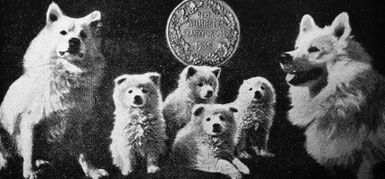
The situation with breeding the white Giant Spitz was made worse by the fact that many dogs had to be killed after the war due to food shortages. At times, in the first years after the war, there was only one breeder who still bred white Spitz, namely Willy Wintzheimer with his kennel "von der Norisschanze". Although large Spitzes were still yapping from the dung heaps in the countryside on many farms at the time, the German Spitz Club did not resort to using these dogs; they were effectively excluded as "non-existent".
The white Spitz has all the characteristics typical of Spitz, although it is a little more moderate than the black Spitz, but should not be underestimated as a guardian. For several years now, "American Eskimo Dogs" have been crossed into this color range. Although they go back to the German Spitz, they have undergone changes both internally and externally through various crossbreeding that now clearly distinguish them from the white Giant Spitz.
Brown Giant Spitz

The so-called unicorns among the Giant Spitzes have always been the brown ones, which used to be mainly found in southern Germany. The long-established kennels, which had already bred large brown Spitzes before WW2, closed their doors in the 1950s. When, after 1968, no brown Spitz could be entered into the studbook at all, the German Spitz Club made another attempt to save the color by allowing brown and black Spitz puppies from Wolfsspitz litters to be bred. These puppies were born in kennel “vom Sonnenglanz”. Unfortunately, there was no success. After the last brown Giant Spitz was born into the "von der Kesterburg" kennel in 1994, the brown large Poms were then considered to be virtually extinct. It wasn't until 2007 that brown puppies were born again through back crossing with brown medium-sized Spitzes. In 2011, the first brown Giant Spitz, which could be bred by back crossing from both black parents, was born in “von Kauthen Ruh” kennel.
Colorful Giant Spitz
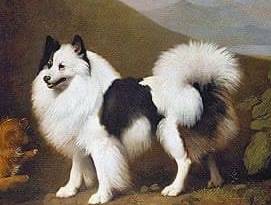
Outside the German Spitz Club - in clubs outside the FCI - there have been increasingly "colorful" Spitz litters for several years now, in colors like piebald or gray, wild-colored, orange, sable, etc. After these colors had more or less disappeared for a long time, these litters a pleasant addition and a nice comeback to the previous color variety.
Despite all the euphoria about these new, "old" colors, breeders should still try not to completely lose sight of the pure-colored Giant Spitz, as these used to make up the absolute majority of the Giant Spitz population - the dogs of other colors, however, only made up a relatively small proportion. Due to the strong focus on colorful litters and the move away from the pure colors black, white and brown, the extinction of them is becoming increasingly likely.
And Spitz colors today?
Today, classifying the expected character traits of the Giant Spitz based on the coat color is no longer that easy. This is due, on the one hand, to the fact that the colors can now be bred with each other again and, on the other hand, to the fact that the Spitz as such has also had to endure a number of cross-breeds: starting with secret cross-breeding in the past of white German Shepherds and Samoyeds, through the transliteration and mating from and with American Eskimo Dogs to the Wolfsspitz or Keeshonden, which are repeatedly crossed into the black Giant Spitz, especially in Eastern European countries. In addition, there is cross-variety mating with medium or small Spitzes. Nevertheless, the color of the coat is definitely a trend that you can use as a rough guide - but it's not a guarantee.
Example: My male Birk has black parents, but they come from black-and-white mating of Giant Spitz. Birk is white on the surface, but in terms of his level of sharpness he corresponds absolutely to a black Giant Spitz, the kind that used to be kept as guards on the farm in earlier times.
Differentiation from Wolfsspitz/ Keeshond

Until 1965, it was customary to breed Wolfsspitz and Giant Spitz with each other from time to time. It was only with the resolution of the 35th general meeting of the German Spitz Club in 1965 that the breeding of Wolfsspitzes with other Spitz varieties was forbidden. Although the varieties have previously been intertwined, it is not the case that Wolfsspitz and Giant Spitz are essentially the same dog. Especially when it comes to the wolf-gray Giant Spitz, there are currently repeated calls for it to be renamed Wolfsspitz for the sake of simplicity. Personally, I don't think this makes sense or is effective, because the Wolfsspitz differs from the Giant Spitz in terms of hair type, figure, head shape and, above all, character.
While the Wolfsspitz is a very serious and independent and headstrong dog, the Giant Spitz is far more choleric and sharper, but also more cuddly. The hot-blooded Giant Spitz wants to please his master, the brave Wolfsspitz just wants to do his own thing.
Of course, that doesn't mean that you can't cross Wolfsspitz into the population of the Giant Spitz, just that this should be done with a lot of sensitivity and under close control of the offspring.
Training
The Spitz has to be trained completely differently than a standard dog. I would even go so far as to say that the standard dog school trainer has absolutely no idea about how to train a German Spitz appropriately. Why can I take relaxed walks in the forest with my dogs without having to worry that they'll run off on me to go hunting? Why can they walk off a leash at night in the middle of a trash-filled city without me having to check to see if they're eating any crap lying around? Why can I tie my dogs up just before the supermarket without having to worry about someone stealing my dogs? Simply because I raised the Spitz like Spitz - and not like poodles or German Shepherds! In contrast to most other breeds, Giant Spitzes actually become adults in their heads - while Labradors & Co. remain eternal, playful puppies. And so the training of the Spitze must be accordingly different.
Nevertheless, proper and well-thought-out dog training is not that difficult. My article about training the Spitz goes further and in detail :
Breed history of the Giant Spitz
Originally, the large Spitzes were only bred on farms for their own use - and until the 19th century, the Spitz was the most common type of dog in Germany. Because the breed was a relatively common working dog breed, the appearance of the animals was of secondary importance at the time.
In 1899, the German Spitz Cub ("Verein für Deutsche Spitze") was founded, and soon it published the first breed standards - as one club of many, because until 1910, German Spitz was bred in seven different dog clubs in Germany. It is known from magazines of the time that the clubs all held their own dog shows. The German Spitz Club finally merged with the German Spitzer Club in 1909 and joined the “Kartell” (forerunner of the German VDH) in 1910, where the German Spitz was already bred in the three varieties Wolfsspitz, Giant Spitz and Miniature Spitz.

Until 1958, the Giant Spitz was available in all possible colors, until it was decided in the same year to breed the Giant Spitz only in black, white and brown color. Only the same colors were allowed to be paired with each other. The Wolfsspitzes have been completely excluded and are currently only allowed to be bred with each other. This means that the genetic basis has been greatly reduced, especially for the large Spitzes.
Due to the fact that our German Spitz hasn't got any hunting drive, from the 1950s onwards - in agreement with many hunters and foresters - some German state hunting associations finally came to the conclusion that the local farmers should again give the good old German Spitz its traditional place as a farm dog, to put an end to the hunting of local farm dogs (mostly German-Sheperd-Mix-dogs). The state hunting associations in Germany and Austria bred Wolfspitzes and black and white Giant Spitzes themselves and gave them to farmers for a steel. In the same way, the purchase of the Giant Spitzes was subsidized by the hunting associations. All of this gave the Spitz breed a bit of a boost - especially when it came to blacks - until the end of the 1960s. Unfortunately, things went downhill rapidly after that and almost ended with the extinction of the Giant Spitz several times. In 1973, just one born puppy (!) was recorded. After that, things gradually started to improve again, but it wasn't until the end of the 1980s that more than 30 puppies were reported again. At the end of the 20th century, the number of registrations fell back to around 20 puppies. What was really worrying, however, was that from 1997 to 1999 there was not a single black Giant Spitz puppy in Germany's studbooks.
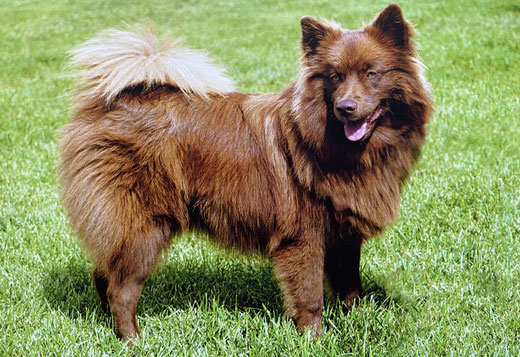
In the GDR there were Giant Spitzes, Wolfsspitzes and Miniature Spitzes (Kleinspitz), with the Miniature Spitzes making up the largest proportion. They were all bred in the VKSK (Club of Allotment Gardeners, Settlers and Small Animal Breeders). The breeding requirements in the GDR were much stricter than in the Federal Republic of Germany, and HD X-rays were made mandatory for the large Spitz and the Wolfsspitz as early as the mid-1960s. While individual black, white and, extremely rarely, brown Giant Spitzes initially existed in the GDR, they had already completely disappeared from breeding by the 1970s and were only imported from Eastern Europe from the beginning of the 1980s. However, the breeding of large Spitz itself in the GDR was carried out in a highly incestuous manner. After the fall of the Berlin Wall in 1991, the VKSK Spitz breeders joined the German Spitz Club.
In 2003, the GEH (Society for the Preservation of Old and Endangered Domestic Animal Breeds) included the Giant Spitz in Category I of the Red List as extremely endangered!
Since 2019, black and white mating of the large Spitz has been allowed again in the German Spitz Club. A breeding program was also published by the Club in 2022, which allows the breeding of large and medium-sized Spitz, but continues to prohibit breeding with Wolfsspitz.
Conclusion
Anyone who is interested in owning a Giant Spitz should first check carefully whether this breed of dog - as it is - suits them and their life. A German Spitz whose body and character corresponds to the current breed standard is a real guard dog - with all the expected advantages and disadvantages:
- A dog that attaches itself primarily to one person in the family and largely only takes orders from that person.
- A dog that is suspicious of strangers and therefore does not approach people it does not know in a friendly manner, and certainly does not allow itself to be "cuddled" by total strangers.
- A very intelligent, very affectionate charmer who always wants to be there - no matter where he goes.
- A reliable protector who, if necessary, will defend his master with his life.
- A child-loving joker, easy to care for and undemanding, who is very attached to his freedom.
- A dog whose training you can never really finish because he always questions things. Everything.
- A dog that doesn't have a penchant for hunting, doesn't stray, and can therefore run a lot without a leash.
- He is not a long-distance runner and is not suitable for people who want to go on 15 miles bike rides with their dog.
- The Spitz despises weakness. If the question of hierarchy is unclear, such a large Spitz can be quite dangerous, even towards its owner. The question of hierarchy is then definitely clarified, at least for the Spitz. He receives signals from humans that he is at least equal in the ranking order, i.e. that he is at the top of the hierarchy. So much for the approach of wanting to act on an equal level with your Spitz. 😉
Addendum
A thief who had escaped impending prison thanks to his lawyer's subtle defense wanted to show his gratitude:
"Give me some advice," said the lawyer, "I have a lonely house. How can I best protect myself from thieves?"
The thief: "You have to get the right dog. There's only one that we can't bribe with treats. Buy a German Spitz!"
06.02.2023
